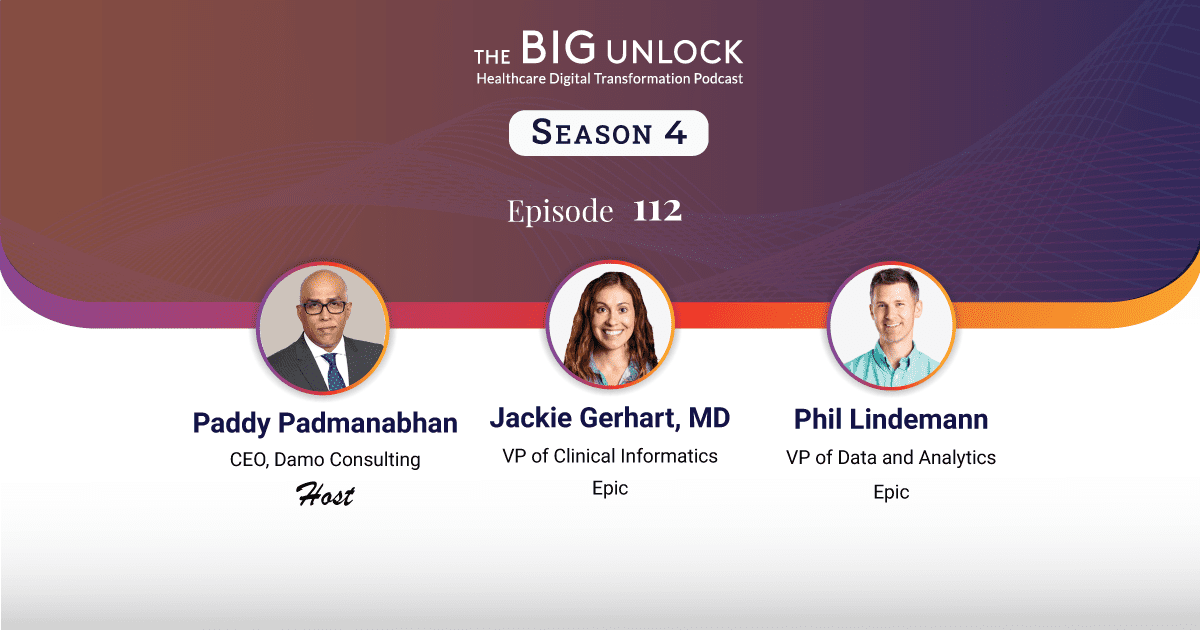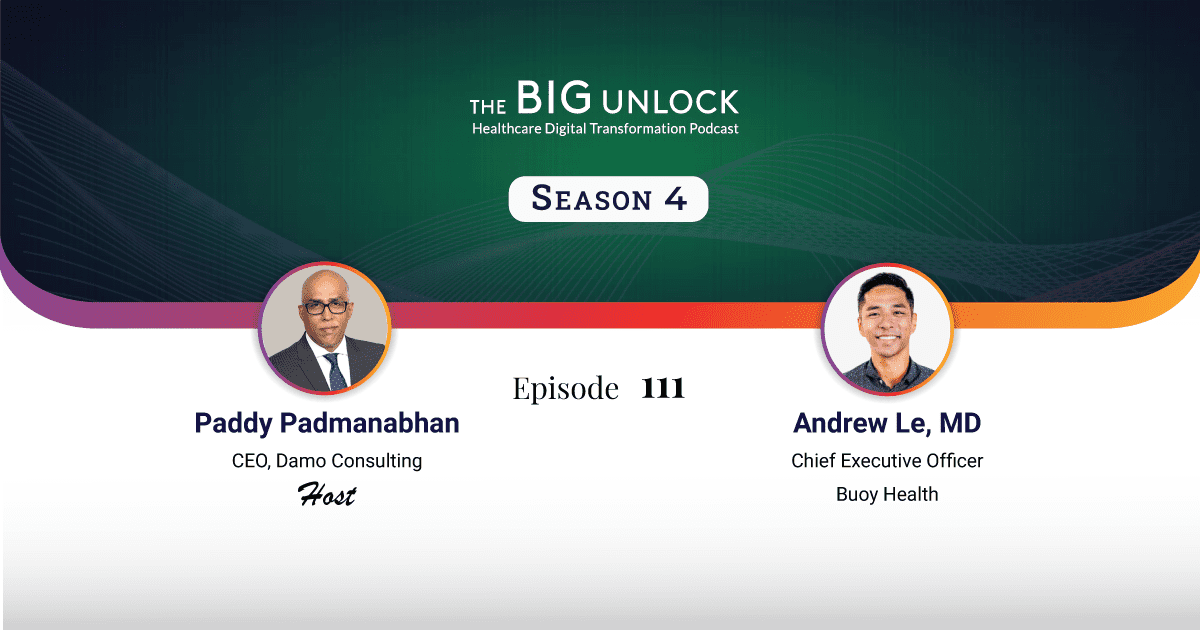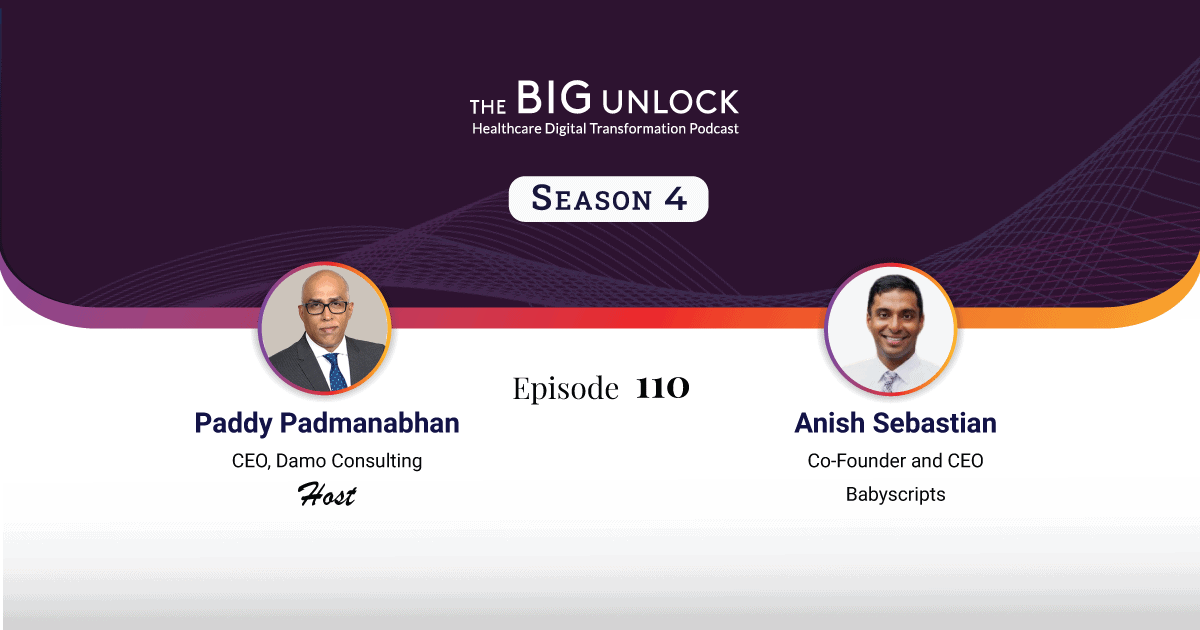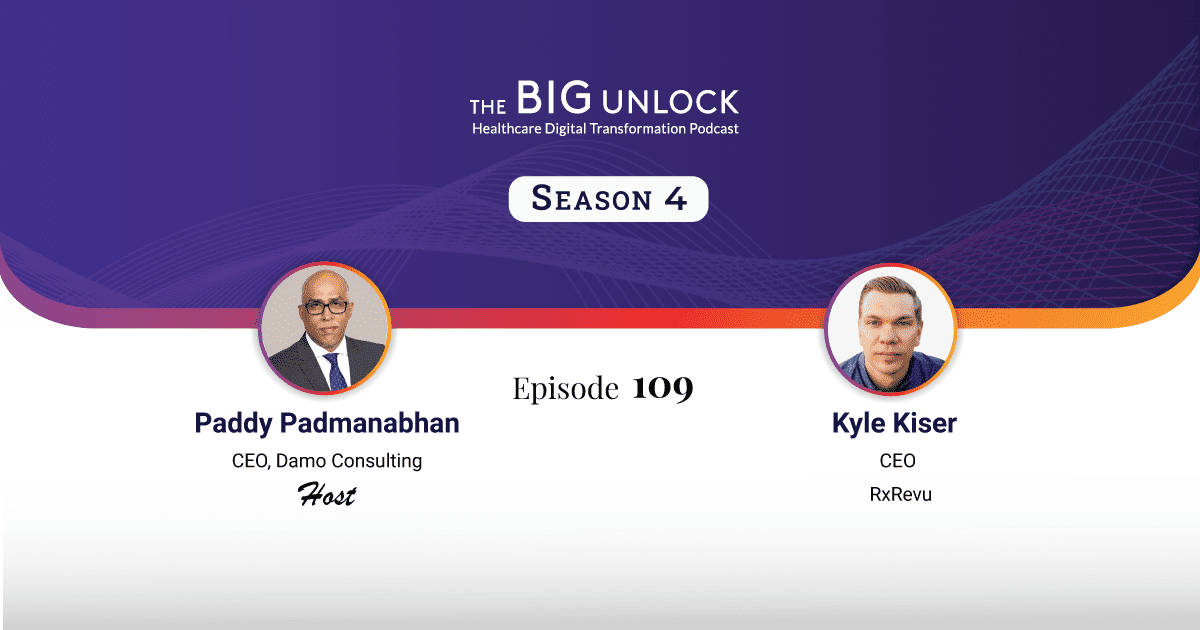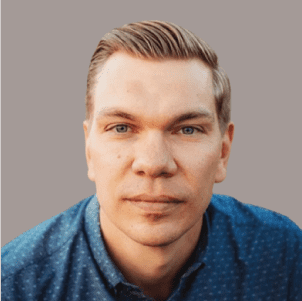Season 4: Episode #112
Podcast with Jackie Gerhart, MD, VP of Clinical Informatics and Phil Lindemann, VP of Data and Analytics, Epic
"Our goal is to have clinicians be able to use tools that help get individualized medicine to the point of care"
 Hosted by Paddy Padmanabhan
Hosted by Paddy Padmanabhan 
Share
In this episode, Jackie and Phil discuss Epic’s Cosmos research database that covers over 130 million patients across 800 health systems in 50 states – the largest single healthcare dataset of its kind. They discuss the role of database in driving the Epic Research initiative, specifically in public health, and explain how they ensure privacy protections and safeguards for the data.
Jackie and Phil also discuss Epic’s recent expansion into newer market segments such as retail healthcare and health insurance, and Epic’s new CRM product, titled Cheers.
Epic is one of the largest healthcare IT companies today and has a significant influence in healthcare operations across the country. Jackie and Phil discuss how the Cosmos dataset could power new innovations and research, and also highlight advocacy efforts with regulatory agencies to reduce coding and documentation burdens on clinicians, at a time when the healthcare industry is facing a shortage of workers.
Show Notes |
||||
| 01:38 | Can you walk us through a high-level overview of the Cosmos platform? | |||
| 04:37 | Tell us a little bit about what you know from the COVID surveillance standpoint? What was the platform able to accomplish for you and how you've used this massive dataset? | |||
| 08:17 | How do you make sure the privacy and security aspect of it? | |||
| 12:23 | There are other health systems doing their own rollout. They've got their own data, they're going to use it, and mine the data for insights they can get and they're going to serve their own patient populations. How is Cosmos data different from others? | |||
| 17:29 | Who gets access to the data sets? What about the private sector? Do developers get access to private or academic researchers? | |||
| 19:34 | So, for digital health startups, the pathway to get access to the data is to either build a product or a final product with one of your customers, which would be a health system or an innovation group. Is that the way it is that? | |||
| 20:43 | Tell us about your new CRM platform – Cheers. How does Cosmos fit into that story? | |||
| 23:42 | Epic, which traditionally has been seen as a health system focused software company, is now branching out. You talked about the work with retailers like CVS, you've announced a partnership with Anthem. How does Cosmos fits in all of this? | |||
| 28:37 | What is your view on how your platform can help alleviate the acute shortage of workers, which has been identified as the number one issue for healthcare CEOs in a recent report by the American College of Healthcare Executives? | |||
About our guest

Jackie Gerhart, MD is the VP of Clinical Informatics at Epic where she works with healthcare executives to advance clinical care and improve clinician well-being. Her current work focuses on the value patients can get from their data and how that information can advance evidence-based medicine and improve outcomes. She leads the clinical team that works on Epic Research studies. She also works on healthcare policy at the local, state, and national levels. Jackie also has an appointment as an Associate Professor of Family Medicine at UW School of Medicine and Public Health and still practices medicine at UWHealth. Jackie earned her MD at Mayo Clinic School of Medicine.

Phil Lindemann is the VP of Data and Analytics at Epic, where over the last 18 years he has worked with various products to define their development roadmap and strategy. He leads the team that works on Cosmos. He has worked on health tech solutions spanning machine learning, data visualization, data quality standards, and real-world evidence generation during his time at Epic.
Q. I am here today with Jackie Gerhart and Phil Lindemann, Senior Executives at Epic. It’s a pleasure to have you on the show. In your roles, your core areas of focus are Cosmos and Epic Research. Can you tell us more about this?
Jackie: I’m Jackie Gerhart. I am a Family Medicine Physician by background, and I’m one of the multiple clinicians at Epic that help make sure that their software is a joy to use. I work with other clinician executives at organizations that provide health care to ensure their workflows are going well and that their clinicians are satisfied.
Phil: I’m Phil Lindemann and I work with our data and analytics teams. What that’s all about is figuring out how to take, at this point, 170,000 different items created by Epic or other systems we work with, make sense of that and serve that back up to users within Epic. So, whether that’s Artificial Intelligence, Seth’s team from your previous conversations, or doing dashboards or even what we’ve been spending a lot of time on — Cosmos.
Q. Who or what is Cosmos? There’s an Epic Research program that is also associated with the Cosmos dataset. Why don’t you walk us through a high level overview of the platform?
Phil: What we’ll do is, I’ll give a little foundational information on Cosmos, and then, Jackiewill tell you what we’re doing with it. So, Cosmos really started as a collaboration with the Epic community a few years ago, where we tried to bring together the information from all of these health systems. The question was –What kind of insights or discovery could we do? So, fast forward a few years and we’re now over 130 million patients across 50 states with over 800 hospitals and 10,000 clinics. All of that data feeds into a central location to be available to researchers and ultimately, come back into the Epic system. When you’ve got that much data together, can you imagine what you could do with it? Jacqui, would you like to talk about Epic research here?
Jackie: Absolutely. Epic Research started right around the same time as the pandemic. It was actually something we had planned beforehand and serendipitously, it came at the same time when we were able to get good information out, quickly. That’s really the goal of Epic Research — to help search the Cosmos to find information or insights that might have taken years to find if following a traditional research process. So that data could have been in a medical journal and maybe, less out in the public eye as the Epic Research platform is. Our goal was to make a website that would enable the generation and pushing out of good insights quickly among the public and in the hands of those that can actually make change and take action from it. We’ve worked with the COVID 19 task forces throughout different government agencies, and our customers to try and ensure that anytime we see something new, we try and extract that data.
Q. Can you tell us, from the COVID surveillance standpoint, what was the platform able to accomplish for you? Do talk about some of the use cases so we understand how you used this massive dataset.
Jackie: Our goal is to get good information out quickly, but we really span the spectrum of trying to write anything that will help the news articles, peer-reviewed journal research etc. out within a day or two. So, I’ll start at the academic end with the peer-reviewed research. We worked with customers like Penn and Yale on an article that was later peer-reviewed and published in the Green Journal, the Journal for Obstetrics and Gynaecology. This was specifically looking at mothers that had had COVID and during what trimester they got COVID and whether changed the outcomes of their babies in terms of low birth weight, preterm birth, etc. That was one of the first studies that was published on pregnancy including a COVID infection and it was able to get out much more quickly than maybe what we would have been able to do and impact those that had COVID, were pregnant and wondering what was next.
At the other end of the spectrum, from a COVID perspective, we also worked with the government. Early on, we first looked at surges, but now, we’ve also been doing that with the CDC for the vaccinations. The goal is to get a vaccine approved and there is a process in which safety is paramount. You’re also looking where the bang for the buck is and whether the benefit is better than the risk that you would take as a patient. We’ve been able to provide a lot of information about patients that have got vaccinated, highlighted the safety implications and the risks to help impact legislative findings. Specifically, we worked on the 5–11-year-olds, and the passing of the EUA for them to get vaccinated. Then, there was the passing of the EUA to get booster shots for Moderna and Pfizer. So those were the COVID examples.
For me, the ones that were most impactful were those that helped drive change — One was in the middle of COVID and the other was related to Cancer screenings. During the pandemic, a somewhat unwelcome side effect was that multiple different clinics were closed so patients couldn’t get their Mammograms or Colonoscopy done. We noticed the screenings plummeted. So, the question was — how would the decreased screening rates of Cancer impact the likelihood that somebody had a missed Cancer or that it was going to be diagnosed at a later stage? We found in our most recently published article, and we’ve been following this over time, that the rates haven’t really caught up, yet. One would think with the clinics opening, perhaps people would be back to get their screenings. But it’s not happened, yet so that leaves some room for improvement.
Q. With such massive datasets, how do you make sure patient privacy is secure? With 130 million patients, you’ve got to have at least one or two of them asking this question.
Phil: Absolutely. When you look at something the size of 130 million — we’re unaware of any other EHR-based data source that’s this big in the US or the world – so, that’s a big undertaking. Talking of privacy and security, the first thing we ensure is no free text, no unstructured data for there’s a chance it could have information. It’s a very simple rule then, that any information that’s brought into Cosmos must have a structured location at an Epic site. This goes way back into our ability to build these integrated medical records such that no matter where you go in the world, Epic is the same code base, even though it might be configured slightly differently in some places, in different scenarios. But the meds are stored in the same location, as are the doctors, so that it made it easy for us to bring all the data together. Still, this is a very hard task, but it was much, much easier than trying to deal with different databases in different ways that things had grown up over the years.
The most important thing from a privacy and security point is, before data even leaves the healthcare organization, 16 direct identifiers are removed from the record, and this is before it arrives in the Cosmos database. Any users interacting with the data are only ever seeing de-identified data through aggregate controls or if the results are few, then, the platform says “there’s fewer than 10 results” rather than show the exact number. There’s certainly a lot of things that we do with the software to protect it.
But another special sauce when you have so many health care organizations and shared trust is the “rules of the road” that they’ve all agreed to. That contains things like — the data can’t be sold, access to the data can’t be sold, the data can’t leave the secure portal etc. These contribute to the shared trust because we’re operating under this general rule of the road and those are governed by the health care systems, themselves. So, they elect a Board that grows more organizations that join Cosmos. They help maintain that the rules of the road will evolve and stay within the spirit and goals of what Cosmos was intended for.
Q. That’s a very important clarification about no free text. I certainly wasn’t aware of that. Now you’ve mentioned this is the largest dataset of its kind in the world, but there are also other similar initiatives, like Truvada or even Mayo Clinic that’s rolling-out their own data for their patient communities. In all cases, the data comes from EHR systems – some of it yours, some, not. Other than the fact that Cosmos is Epic data, and I’m assuming only Epic data, how else is it different?
Phil: The only Epic data is, when you think about what we know and what we’ve learned about healthcare, by making the actual data creation systems. We’ve created the medical record in the models. We know what those screens look like, the interactions occurring there, and we understand how data is created. Knowing the origin of data is really important for a researcher who’s making sense of it once it arrives. So, from a quality standpoint, that’s one of the things that we see as magical.
What Cosmos is — All the data comes from a uniform source where we actually understand how it was created. We go back to the source to see what’s happening in that workflow. From a data quality perspective, one of the things we do when an organization on-boards the Cosmos is run all of their data, even an individual lab result, through a series of data quality checks. And it’ll be fascinating because we’ll find out that they’ve had a particular lab value which doesn’t look anything like that same lab value in Cosmos which we’ve worked with. We may think it was mapped incorrectly but what that means is that same mapping is what’s used to interoperate that chart across wherever that patient goes. So by joining Cosmos, these groups actually raise the overall ability to interoperate data and health care in an identifiable state. So, it’s exciting that there’s some pleasant side-effects when they do join Cosmos from a data quality perspective. That’s just a mild differentiator yet it’s important.
But you know, there’s a lot of these groups that are doing irrigation-type things – some, our own customer and that’s great – but many, have unique models out there of what they’re trying to achieve. Lots of people can do analyses, research but we have some of the highest quality data that can drive high quality research. The real sort of North Star for us is, how do we bring that information back to the fingertips of the clinicians and building tools that are directly within Epic? And actually, Jackie you may want to talk about some of the things we do.
Jackie: I’ll back up and add to your initial question about, what’s our differentiator — why use Cosmos? For me, having used it in research, it’s really the size and the representativeness as well as the speed at which you can get those insights into the hands of those that can act on them. A couple of instances specifically in working with the CDC is that, for example, we’ll be sharing data about hospitalizations for kids. They get information from their public health registries and multiple different areas but that will be delayed at times and getting that relayed to those that can use it consequently also gets delayed. But that delay is greater than the delay we have with Cosmos. As soon as a clinician or a patient enters information into the record and it goes into Cosmos, it can be surfaced to have decisions made on it. One example concern using MIS-C, which is an inflammatory syndrome in kids. We were told by folk at the CDC that we had data that was a good month ahead of some of the sources that they had. And this made a difference especially when we were dealing with something like the Omicron. So, speed and size matters.
It is really hard to do research on a representative dataset, especially one that represents the US population. So you can imagine that why Epic customers and Mayo Clinic etc., have their own data sets. Often, when you’re using one organization’s data, there’s a certain type of patients that might go there. That might be the population that happens to be in Minnesota, or the population that happens, to your point, to seek Cancer care. And so they might have a sort of larger representativeness of a certain specific type of question that they’re looking to get answered. But overall, when researching general broad questions, really having the scale, age, sex, race, and ethnicity and as that social vulnerability index breakdown that really matches the US population, it’s really a huge step from our research perspective.
Q. Let’s look at the other end of the spectrum — Who gets access to the dataset — private sector, developers, academic researchers?
Jackie: I wanted to follow up on what Phil was mentioning about how he put it in front of the physicians/clinicians. Who gets access, you ask? One of the main goals here, in addition to research, is to put the data and insights in front of a clinician at the point of care so clinicians that are using Epic software, can use tools that help them to really get individualized medicine to the point of care. So Epic users will be able to use the Cosmos dataset. And one of the main intentions is to bring evidence-based medicine directly to the exam room. Phil, do you want to talk about the other users that use it for research purposes?
Phil: Just so there’s a general understanding — the health care organizations that participate in Cosmos are the ones that actually get to touch the data. That’s about 1,000 users across all the different organizations, today. Now the nice thing about it is, they can work on sponsored work for other industry partners. So we really see it as a way to drive research to some of those groups that are participating in Cosmos. They work with an organization, derive some insights whether that’s a paper or an algorithm, but we really do see this being an ability to create lots of different things off of the Cosmos dataset. While its ok for insights to leave Cosmos, that raw underlying data is only touched by the Cosmos researchers in the Cosmos system.
Q. So, how does one get access – does a digital health start-up listening to this podcast for example, either build a product or partner with one of your customers, a health system or an innovation group, and thus, potentially get access. Is that the way it is?
Phil: We should preface it by saying it’s early days for us. We’re still figuring out how these models will work but when we thought this through, we felt Epic certainly can work and do many of these things. When you unleash this on the research community and have them interrogate the data and do the queries, they’re the ones that can work with the digital health start-up, ask the questions and derive the insights to inform their product and then, build them.
Q. Awesome. Now that you are taking Cosmos out into the market and you’re looking at newer users, tell me, how does Cosmos fit into the Epic and the CRM platform, Cheers, story?
Jackie: So, Epic has many health care organizations that we work with and in the concept of bringing in more patients the right care, in the right way, at their timeframe, we’ve really been looking at ways to try to open it up to health care organizations to have that ability to give patients what they need, when they need it. The differentiator for us is that we are deeply embedded in health care so, we’ve worked many times on things such as, MyChart in the patient portal and so forth, but it really goes beyond that. That was the impetus for Cheers as a CRM application.
It’s really the CRM that is specifically tailored for health care so that we get advice from our current customers who are looking to implement something like that, apply that directly into the research and development of the product before they take it. Phil, I think there are a couple of other things you wanted to add for that.
Phil: It’s funny we finally did name our CRM, but it’s something that we have had for over a decade that we’ve been using and learning. It’s something that our health plan customers do and our diagnostic laboratories use it. We’ve had a lot of experience building and integrating it into the various facets of the organization to understand our patients better. But one of the real insights for us as we started working with customers that were more in the retail space — So CVS, Walmart — was that it really helped inform our roadmap of where it needed to go. A few years ago, we added a Campaign Module to that. But you know how the naming process is always an art any time you’re naming a product. This year, finally, we concluded that Cheers would be it. So, a great announcement came with that.
Q. The name is only one part of it. You have a CRM product now and that in itself is a big deal. You’re working with retailers like CVS, have a partnership with Anthem, something going on with Humana, too. So, where does Cosmos fit into all this?
Phil: Just to drill down a little bit more on the on the payer relationship, we’ve always had teams and customers that have been working in this larger ecosystem, and we’re starting to expand, to build solutions, to reduce some of that friction. The payer space was a big one where we were seeing groups move to value, which was good. They were asking for more information so there was a lot of back and forth with the payer than we’d done, before. This wasn’t just simply “submit the claim and get paid”. It became much less transactional and back and forth. So we thought of working on something that would have a shared benefit for the payer and the health care system to really reduce some of that friction. And developed a payer platform and a series of things like the pre-op you mentioned. At this point, we have five of the six largest payers participating on that platform, and it’s about a hundred million patients that those represent.
So it’s really taken off, continues to grow and has another roadmap. That’s probably another podcast worth of discussion for you to have that team come and talk. Nevertheless, it’s a big part of what we’re doing to help ease the movement of that information — just the right information — because obviously, it’s got different viewpoints from the payer and the health care system
Q. Epic Research, Jacqui, there’s also been some interesting work done on public health and safety by helping identify practices like human trafficking. Want to touch on that briefly?
Jackie: Sure. So, we have a few different websites at Epic. One is Epicresearch.org which shows all the studies that we do on Cosmos. Then, the Epicshare.org. And then, just overall Epic.com. When you’re looking at different studies and outcomes that our customers have or if they’ve piloted something and then, worked on that initiative, you can access those websites and read the success stories.
The one that you’re specifically referring to was where one of our customers — Henry Ford Health System — did a training and used the software to actually ask the right questions at the right time and help identify more of the human trafficking victims. Their exact program involved three things – a. increasing the screening so that the folks that were seeing people come through the emergency room were able to identify certain behaviours or cues, b. having those people be trained so that when those cues were identified, they knew how to act and c. ensuring that they were getting support to those patients, as well. We have these things that, I call, clinical programs, where when a customer does something really amazing and it could be scalable or put across the rest of the app community, we package it up and put it on one of our websites and have it made available to anyone that wants to try to do it in another hospital.
Q. That’s so great. I want to touch on just one other topic. Today, we’re in the midst of a brand new crisis that we didn’t expect — an acute shortage of health care workers. Technology is one of many solutions to alleviate that and you’re one of the biggest technology providers in the health care/health system space. What is your view on how your platform can help alleviate the crisis identified as the number one issue for health care CEOs in a recent report by the American College of Healthcare Executives?
Jackie: I love how you started with there’s so many pieces to that puzzle because that is the issue. There’s just so many reasons that healthcare professionals and clinicians, especially amidst a pandemic, are struggling to determine what their path and calling is to be able to provide health care. On the non-technology spectrum, we’ve really been encouraging and working with outside groups, whether that be CMS regarding ENM coding to try to decrease the number of things that people need to document, either in flow sheets for nurses notes or in billing types of situations for physicians.
We’ve done a lot of things with partnerships — we have is that 25 by 5 initiative, which is Vanderbilt, Columbia; I believe now even the AIMIA (the American Medical Informatics Society or Association); and then, the National Library of Medicine — are all going together to reduce documentation burden by 25% by 2025. So, it’s all about really leaning-on and collaborating with others in that community to learn their success stories.
Beyond that, in the software there are a couple of different things. I did mention how we have websites where we share customer success stories. One of the most recent ones that was published from UC Health describes how their project saved 64,800 hours of nurse-time annually, thanks to the processes within EHR and documentation changes. This also reduced clicks by 50%, lowered the number of flow sheets that the nurses need to fill out, and the length of those flow sheets was shortened by about 65%.
Those are some direct examples, but we’re really thinking of it on a broader innovation scale as well. One of the key areas we’re innovating in, is Voice. So, like how you might use Siri or Alexa, for clinicians we have the Haptic where you literally ask your phone a query. The application on your phone, Haiku, curates what you’re looking for, so you don’t need to spend time looking for it in the chart. So “show me my next appointment” “Show me Janet …. ABC,” or the different pieces that may take time looking up –We’re reducing that piece.
The other promise of Voice is, if it’s intelligent enough to be able to listen to a clinician’s conversation with a patient, is it possible to get it to document it too? How can action be taken so that clinicians don’t have to sit at the computer? The computer will never replace the empathy and the social cues that a clinician can pick-up on during a patient-visit. So, it should be used to enhance and elevate the time that you’re able to see those. Voice technology is one of the ways that can happen.
Q. These are great examples. And you know, the irony of technology is that sometimes technology can actually increase the burden on users. I’m sure it comes as no new news to you that, you know, that the EHR has been, fairly or unfairly accused of increasing burdens. But it’s so encouraging to hear that you’re working on reducing coding requirement, improving documentation and workflow. That’s a story that needs to be told a little bit more; perhaps on another podcast because it is such a hot button issue today in the context of the shortage of workers and the burdens on them. I’m afraid we’re going to have to leave it there today. It was fantastic talking to both of you and wish you all the best with Cosmos and cheers and all the other work that you’re doing. Thank you once again for coming on my podcast!
We hope you enjoyed this podcast. Subscribe to our podcast series at www.thebigunlock.com and write to us at info@thebigunlock.com
Disclaimer: This Q&A has been derived from the podcast transcript and has been edited for readability and clarity
Recent Episodes
About the host
Paddy is the co-author of Healthcare Digital Transformation – How Consumerism, Technology and Pandemic are Accelerating the Future (Taylor & Francis, Aug 2020), along with Edward W. Marx. Paddy is also the author of the best-selling book The Big Unlock – Harnessing Data and Growing Digital Health Businesses in a Value-based Care Era (Archway Publishing, 2017). He is the host of the highly subscribed The Big Unlock podcast on digital transformation in healthcare featuring C-level executives from the healthcare and technology sectors. He is widely published and has a by-lined column in CIO Magazine and other respected industry publications.
